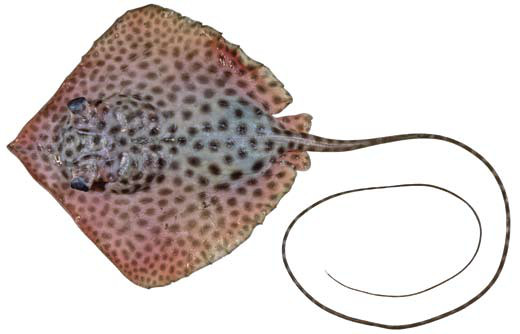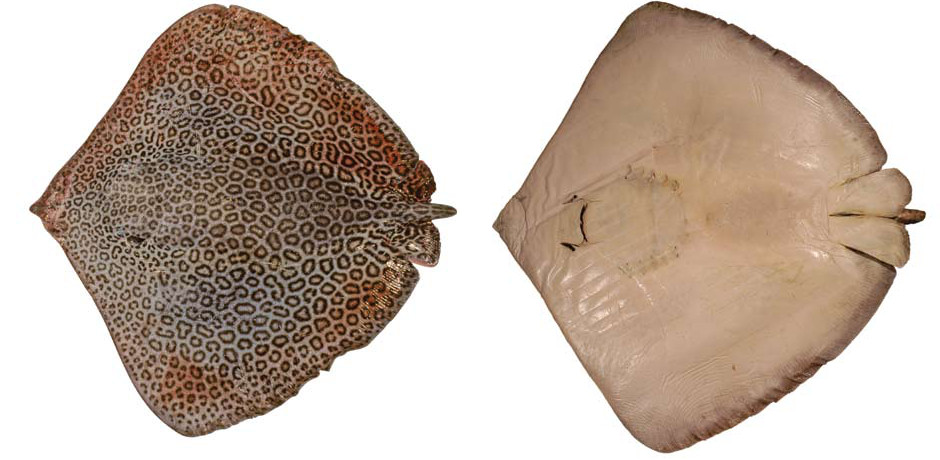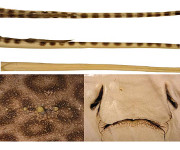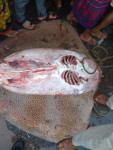Himantura leoparda
Manjaji-Matsumoto & Last, 2008
Classification: Elasmobranchii Myliobatiformes Dasyatidae
Reference of the original description
Himantura leoparda sp. nov., a new whipray (Myliobatoidei: Dasyatidae) from the Indo-Pacific. CSIRO Marine and Atmospheric Research Paper, 22, 293–302
Himantura leoparda sp. nov., a new whipray (Myliobatoidei: Dasyatidae) from the Indo-Pacific. CSIRO Marine and Atmospheric Research Paper, 22, 293–302
Image of the original description

Dorsal view of: Himantura leoparda sp. nov, early juvenile paratype (CSIRO H 635–02, female 200 mm DW, preserved); In: MANJAJI-MATSUMOTO, B.M. & Last, P.R. (2008): Himantura leoparda sp. nov, a new whipray (Myliobatoidei: Dasyatidae) from the Indo-Pacific. CSIRO Marine and Atmospheric Research Paper, 22: 293-302

Dorsal view of: Himantura leoparda sp. nov, early juvenile paratype (CSIRO H 635–02, female 200 mm DW, preserved); In: MANJAJI-MATSUMOTO, B.M. & Last, P.R. (2008): Himantura leoparda sp. nov, a new whipray (Myliobatoidei: Dasyatidae) from the Indo-Pacific. CSIRO Marine and Atmospheric Research Paper, 22: 293-302
Synonyms / new combinations and misspellings
Himantura cf. leoparda
Himantura cf. leoparda
Types
Himantura leoparda
Holotype: CSIRO: H 2903-01; Paratype: CAS: 213280; CSIRO: H 635-02; CSIRO: H 5585-02; CSIRO: H 5478-01; CSIRO: H 5284-05; CSIRO: H 3903-02; CSIRO: H 4131-01; CSIRO: H 3863-02; CSIRO: H 3863-01; IPMB: 38.01.04; NTM: S 10765-002;
Himantura leoparda
Holotype: CSIRO: H 2903-01; Paratype: CAS: 213280; CSIRO: H 635-02; CSIRO: H 5585-02; CSIRO: H 5478-01; CSIRO: H 5284-05; CSIRO: H 3903-02; CSIRO: H 4131-01; CSIRO: H 3863-02; CSIRO: H 3863-01; IPMB: 38.01.04; NTM: S 10765-002;
Description :
Citation: Himantura leoparda Manjaji-Matsumoto & Last, 2008: In: Database of modern sharks, rays and chimaeras, www.shark-references.com, World Wide Web electronic publication, Version 01/2026
Please send your images of "Himantura leoparda" to info@shark-references.com

Himantura leoparda sp. nov, female holotype (CSIRO H 2903–01, 1105 mm DW, preserved): dorsal view; ventral view. In: MANJAJI-MATSUMOTO, B.M. & Last, P.R. (2008): Himantura leoparda sp. nov, a new whipray (Myliobatoidei: Dasyatidae) from the Indo-Pacific. CSIRO Marine and Atmospheric Research Paper, 22: 293-302

Himantura leoparda sp. nov, female holotype (CSIRO H 2903–01, 1105 mm DW, preserved): dorsal view; ventral view. In: MANJAJI-MATSUMOTO, B.M. & Last, P.R. (2008): Himantura leoparda sp. nov, a new whipray (Myliobatoidei: Dasyatidae) from the Indo-Pacific. CSIRO Marine and Atmospheric Research Paper, 22: 293-302
Common names
 Leopard whipray
Leopard whipray
 Leopard whipray
Leopard whipray
Short Description
A species of Himantura distinguished by a combination of the following features: disc rhomboidal; preorbital snout moderately long, with a distinct apical lobe; lateral apices moderately angular to narrowly rounded; orbits moderately large, protruded slightly; dorsal surface entirely covered with moderately large dark brown polygonal spots in young, large (>550 mm DW) specimens with thick, dark brown irregular rings (often incomplete, leopard-like ‘spots’); tail of young with dark spots on each dorsolateral surface between base and sting; tail banded behind sting, with alternating dark and pale rings dorsally, uniformly pale ventrally. Primary denticle band forming a single row of enlarged, widely spaced, narrow, heart-shaped denticles; two prominent broad heart-shaped suprascapular denticles, preceded and followed by up to 9 and 5 smaller primary denticles, respectively; pectoral-fin radials 148–158; vertebral centra (excluding synarcual) 117–123; including synarcual 120–126. [3354].
A species of Himantura distinguished by a combination of the following features: disc rhomboidal; preorbital snout moderately long, with a distinct apical lobe; lateral apices moderately angular to narrowly rounded; orbits moderately large, protruded slightly; dorsal surface entirely covered with moderately large dark brown polygonal spots in young, large (>550 mm DW) specimens with thick, dark brown irregular rings (often incomplete, leopard-like ‘spots’); tail of young with dark spots on each dorsolateral surface between base and sting; tail banded behind sting, with alternating dark and pale rings dorsally, uniformly pale ventrally. Primary denticle band forming a single row of enlarged, widely spaced, narrow, heart-shaped denticles; two prominent broad heart-shaped suprascapular denticles, preceded and followed by up to 9 and 5 smaller primary denticles, respectively; pectoral-fin radials 148–158; vertebral centra (excluding synarcual) 117–123; including synarcual 120–126. [3354].
Distribution
Indo-West Pacific: Africa to New Guinea, north to Thailand and south to Australia.
First record: 2017: Turkish coast (36°10′54.78″N; 35°48′1.96″E), live specimen, sandy bottom, 130–150 m depth, on 24 January 2016 [25031] Source: www.gbif.org
Indo-West Pacific: Africa to New Guinea, north to Thailand and south to Australia.
First record: 2017: Turkish coast (36°10′54.78″N; 35°48′1.96″E), live specimen, sandy bottom, 130–150 m depth, on 24 January 2016 [25031] Source: www.gbif.org
Size / Weight / Age
110.5 cm WD (female)
110.5 cm WD (female)
Remarks
shark-references Species-ID=2906;
shark-references Species-ID=2906;
Parasites (arranged by Jürgen Pollerspöck)
Cestoda
Hirudinea
Cestoda
- Anthocephalum meadowsi Ruhnke, Caira & Cox, 2015 [22027]
- Rhinebothrium leopardense Trevisan & Caira, 2020 [29331]
- Rhinebothrium nandoi Trevisan & Caira, 2020 [29331]
- Rhinebothrium ruhnkei Trevisan & Caira, 2020 [29331]
- Seussapex sp. [23959]
- Stillabothrium lunae Ruhnke, Aguilar & Reyda, 2022 [30721]
- Tetragonocephalum passeyi Jensen, 2005 [23959]
- Tetragonocephalum sp. [23959]
Hirudinea



















